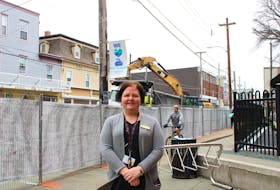In February, Statistics Canada released new data comparing poverty rates of 2015 to 2017 by province. It revealed that while the country saw a decrease in Canadians under the age of 18 who live in low-income households from 13.3 to nine per cent, Nova Scotia was the only province that saw an increase from 15.7 per cent in 2015 to 17.1 per cent in 2017.
When the numbers went live, the Herald consulted Lynn Hartwell, deputy minister of Community Services with the Nova Scotia provincial government. Hartwell said the province is working with Statistics Canada to try to shed more light on the sectors that are most affected, to inform future programming. She also pointed out the province is two years into a four-year, $20-million poverty reduction blueprint, aimed at getting to the root causes of poverty.
Child poverty is parent poverty — why supporting families matters
Developmental disadvantage
The new Stats Canada data shows that 8,000 babies, from birth up to two years old, lived in poverty in Nova Scotia, representing the highest rate of poverty among children. This means we have these highest rates of poverty in our youngest members of society who are at the most vulnerable time of their lives developmentally. This is a vital period in an individual’s life as it sets the stage for their lifelong physical and psychological health.
Increasing costs and decreasing opportunities
More than 83,000 families in Nova Scotia are receiving the Canada child benefit and getting, on average, $635 a month. Vince Calderhead, a Halifax based pro bono lawyer explains that the short-sighted policy-making, such as the province has in the area of social assistance, citizens will end up paying many times more in health-care costs, in justice system costs, in lost opportunities for people to contribute to the economy. This results in more than $52 million spent every month in the province on child benefit alone.
Escaping to survive

In addition to the financial support offered by the provincial government, there are other resources that help women and families avoid the danger of slipping below the poverty line when leaving desperate situations. We speak with Kelly Deveau, mother of three and survivor of domestic abuse who was able to avoid poverty and escape from the home of her alcoholic husband with the help of Alice Housing. The Dartmouth-based non-profit provides safe housing and supportive counseling to women and children fleeing domestic abuse. Brave, vulnerable, and inspiring, see Deveau’s full story here.
Looking at where we are today:

Last week, 10 months since the release of the stats Canada report, The Herald spoke with Acadia University sociologist Lesley Frank who predicted the province would opt to discredit the numbers as they’ve done for years. Having dedicated two decades to tracking child poverty, Frank shares with us her insights on the root cause of the province’s poverty, which is seated in the decisions of the provincial government. The recommended first course of action? Substantial increases to social assistance.

By the numbers — social assistance
Social assistance (also known as ‘income assistance’ or ‘welfare’) is a provincial government program providing people in financial need with assistance in basic needs such as food, rent, utilities, power, clothing. It may also help with child care, transportation, prescription drugs, emergency dental care and eyeglasses.
- A single, non-disabled person welfare eligibility: $575 per month.
- A family of two welfare eligibility: $775 per month
- A family of three or more: $995 per month.
- “Affordable” housing rent: $550 per month for a single bedroom unit, $650 a month for two bedrooms.
- The average cost per adult to meet a basic nutritious diet in Nova Scotia: $284.92 (Number based on the average cost per aged 31-50 male and female, see full report by Mount Saint Vincent University with Voice of Food Security in Nova Scotia here)
Struggling to survive on social assistance

Dianne Crosby’s story depicts this kind of ‘short-sighted policy making’ that leaves citizens on social assistance with simply not enough to get by on. Crosby’s degenerative spine condition forced the Kentville resident to quit her job as a cook at Acadia University seven years ago. She relies on a monthly disability allowance and spends most days confined to her apartment. She's forced to make due with an $846 monthly social assistance allowance, of which $570 goes to rent, medications not covered by the province and other necessities. According to the 2017 Mount Saint Vincent University’s Food Action Research Centre study, Crosby falls significantly short of what is required to eat a minimally nutritious diet alone. You can read the full interview here.
With files from Andrea Gunn, John McPhee and Andrew Rankin with the Chronicle Herald









